%20Definition%2C%20Formula%2C%20and%20Importance.jpg)
Are you looking to understand a company's true worth? If yes, then one powerful metric for doing just that is Enterprise Value (EV). Whether you are an investor, business owner, or financial analyst, knowing how to access a business's overall value is important.
EV goes beyond simple market capitalization; it gives a fuller picture of a company’s worth by including debt, cash, and other factors that can significantly impact financial decisions. In fact, savvy investors and business leaders rely on EV to make informed choices about mergers, acquisitions, and investments.
But how is it calculated? And why is it so important? Let’s break down the formula, its significance, components, and applications, as well as how it can give you a deeper understanding of a company's financial health.
When a company like yours needs a clear and comprehensive understanding, enterprise value (EV) comes into the picture. It’s a direct valuation metric that serves as both the starting point and, in some cases, the endpoint for assessing acquisition prices and a business's overall worth.
Enterprise value (EV) represents a company’s total value in terms of its financing structure. It is calculated by adding the market capitalization (the current share price) to the company's debt and then subtracting its cash reserves. This formula reflects the total amount a buyer would need to pay to acquire the business fully.
Enterprise Value = Market Cap + Debt - Cash
Enterprise Value (EV) plays an important role in mergers and acquisitions because it reflects the total value of a business, not just its equity. By including debt and cash in the calculation, EV offers a more accurate and actionable picture of what acquiring a company would truly cost.
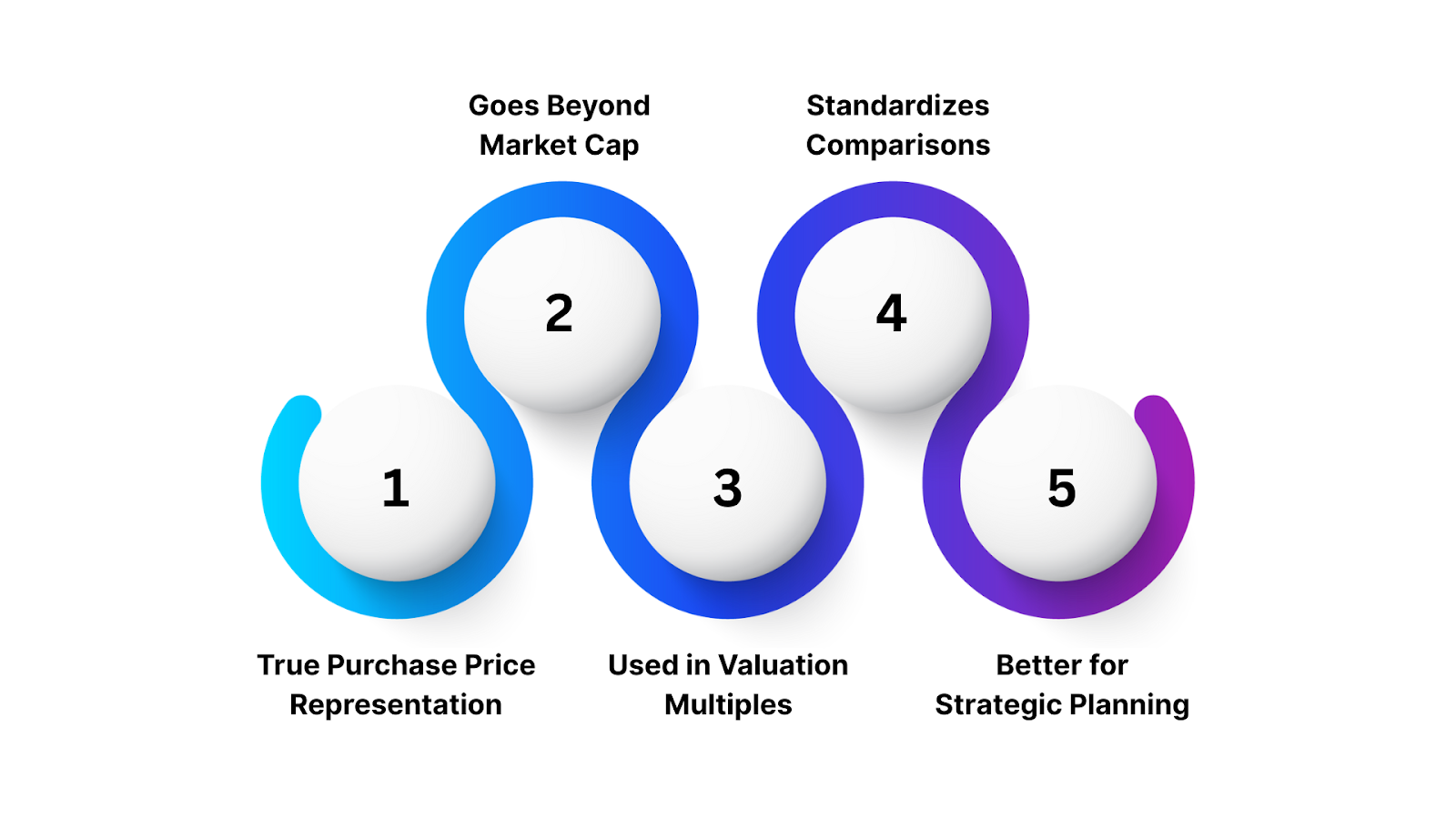
Also Read: How ERP Software Can Improve Your Trading Business
EV serves as the foundation for understanding the costs of acquiring a business, including all debts and assets involved. Below, you will explore the component of enterprise value (EV).
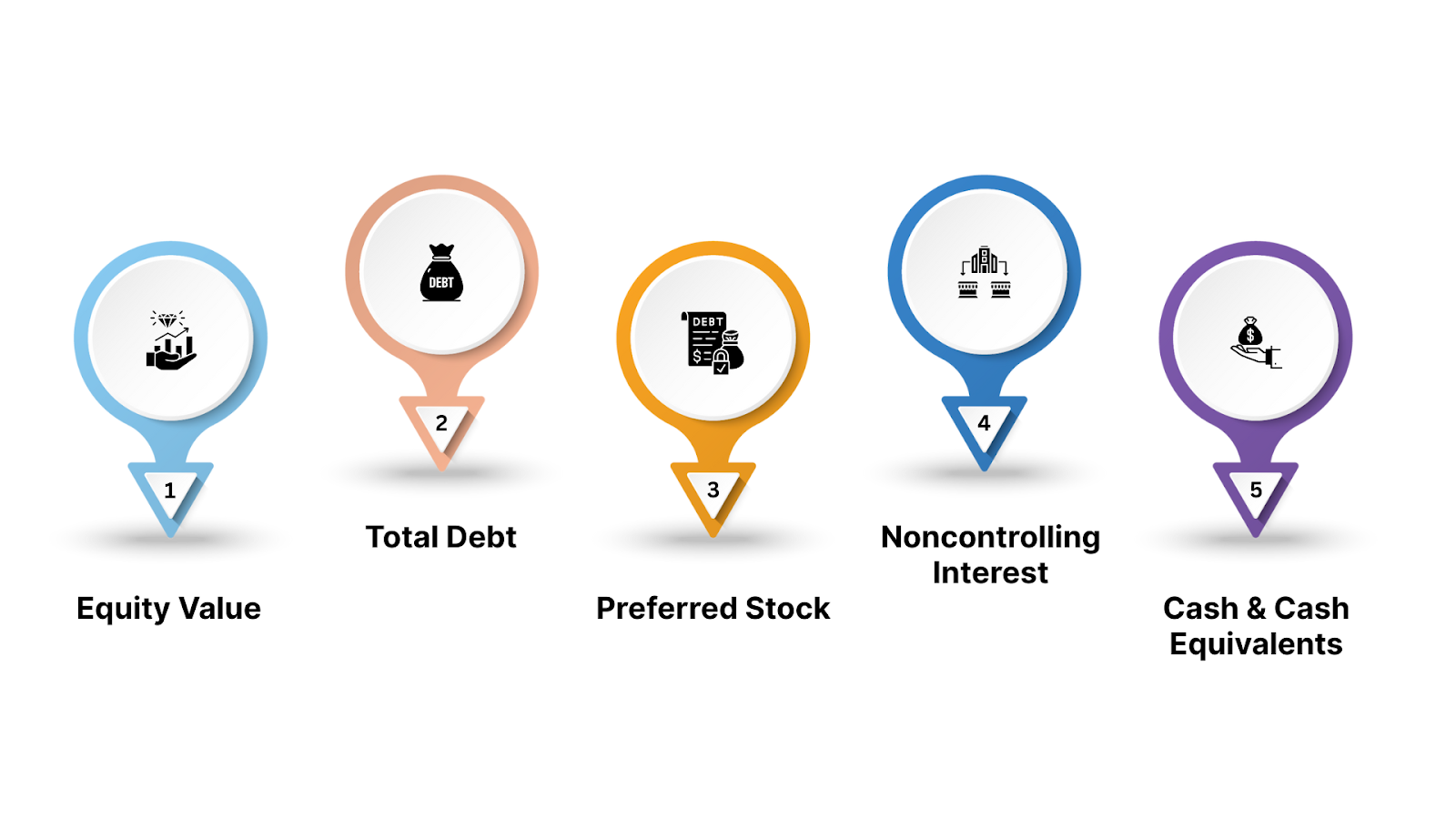
Enterprise Value (EV) is critical in mergers and acquisitions because it provides a complete picture of a company's worth. Below are the key components that make EV:
Equity value is the market value of a company’s equity, which is calculated by multiplying the company’s fully diluted shares outstanding by its current market price. "Fully diluted" refers to shares that include in-the-money options, warrants, and convertible securities, not just the basic shares outstanding.
Equity Value = Fully-Diluted Shares Outstanding × Stock Price
Total debt includes all interest-bearing liabilities, both short-term and long-term, such as loans, bonds, and other debt instruments. When calculating EV, the company’s debt is adjusted by subtracting its available cash reserves, as the acquirer can use that cash to help pay down the assumed debt. If the market value of debt is unknown, the book value of debt is often used as a proxy.
EV Adjustment = Total Debt - Cash
Preferred stock is a hybrid security, combining features of both equity and debt. However, in the context of EV, preferred stock is treated more like debt because it pays a fixed dividend and has a higher claim on assets and earnings than common stock. In an acquisition, preferred stock typically must be repaid, just like debt, and is added to the EV calculation.
Noncontrolling interest represents the portion of a subsidiary that the parent company does not own. When a parent company holds a majority but not 100% ownership in a subsidiary, the noncontrolling interest must be included in the EV calculation. This is because the parent company consolidates 100% of the subsidiary’s financial results, including revenues, expenses, and cash flow, even if it does not own the entire business.
EV Adjustment = Noncontrolling Interest
Cash and cash equivalents include the most liquid assets on the company’s balance sheet, such as short-term investments, marketable securities, commercial paper, and money market funds. Cash is subtracted from EV because it reduces the cost of acquiring the company. The acquirer can use the target company’s cash immediately to pay off part of the acquisition cost, whether it’s to pay down debt or distribute dividends.
EV Adjustment = Cash and Cash Equivalents (Subtracted from EV)
Overall, to calculate the Enterprise Value of a company, you start with its equity value and then adjust for total debt, preferred stock, noncontrolling interest, and cash. The formula for EV can be expressed as:
Enterprise Value (EV) = Equity Value + Total Debt + Preferred Stock + Noncontrolling Interest - Cash
Each component of EV plays an important role in finding the total cost of acquiring a company and should be carefully considered during the evaluation process.
Also Read: Understanding Enterprise Project Management: Strategies and Benefits
In the section below, you will explore the formula for calculating EV.

There are two common ways to calculate EV, depending on the components included in the company’s capital structure.
This formula is often used when the company’s capital structure is relatively straightforward and fewer adjustments are needed. This simple version of EV is calculated by adding the market capitalization (equity value) to the company’s debt and subtracting its cash reserves.
It’s quick and efficient but may not account for more complex situations involving preferred stock or noncontrolling interest.

Simple Formula: EV = Market Capitalization + Market Value of Debt – Cash and Equivalents
Example:
Enterprise Value = 360,000,000 + 90,000,000 – 45,000,000 = SAR 405,000,000
This method is quick and practical for small or mid-sized companies without complex financial instruments.
The extended formula provides a more accurate measure of EV for companies with more complex capital structures such as those with preferred stock, noncontrolling interest, or other liabilities. It’s especially useful for businesses with multiple layers of financial instruments that affect the acquisition cost.
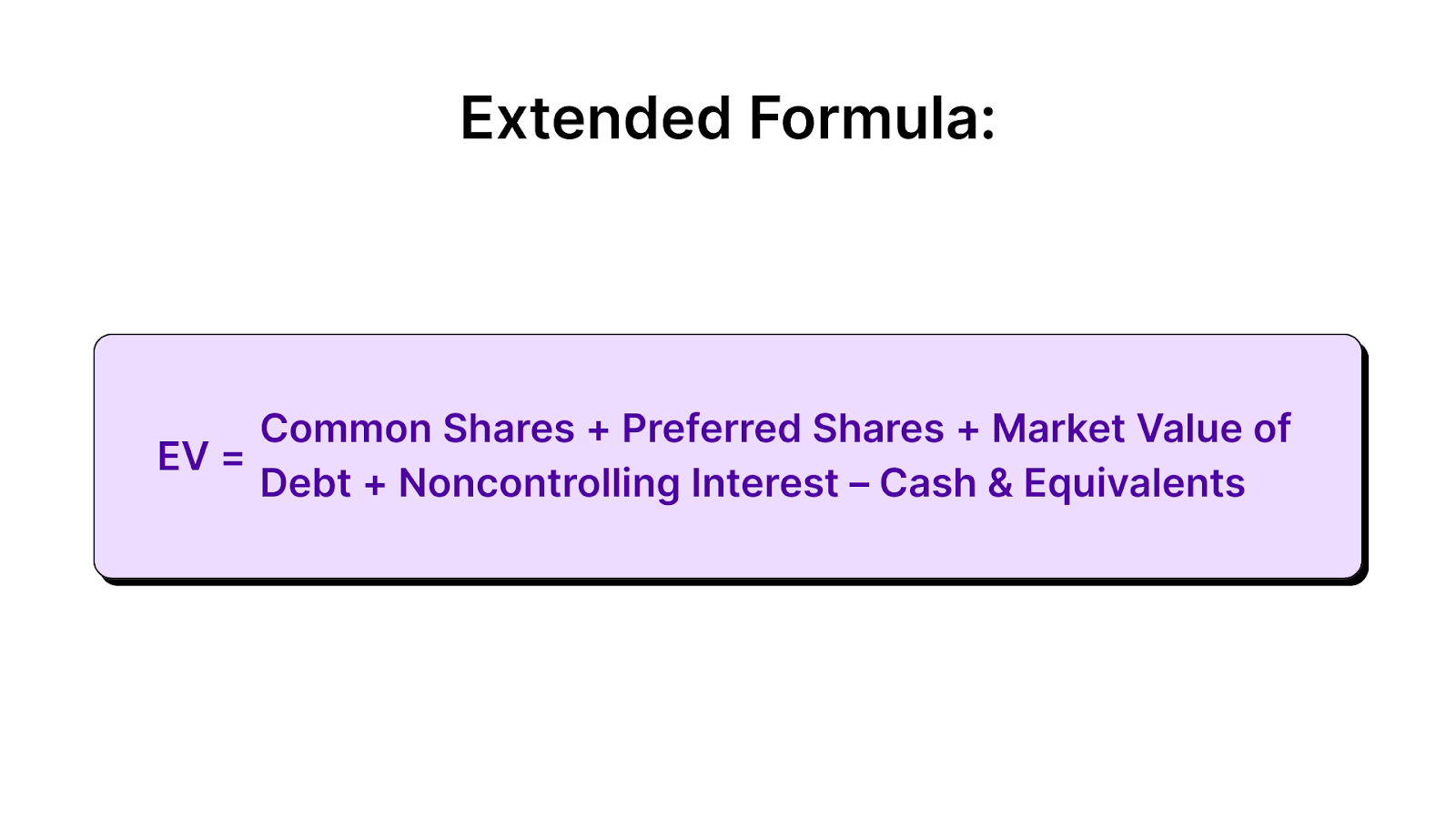
Extended Formula: EV = Common Shares + Preferred Shares + Market Value of Debt + Noncontrolling Interest – Cash and Equivalents
Example:
Enterprise Value = 450,000,000 + 67,500,000 + 180,000,000 + 22,500,000 – 90,000,000 = SAR 630,000,000
This approach offers a more complete view of a company’s value, particularly important for M&A in large or diversified businesses.
Also Read: 8 Steps in the Accounting Cycle Process – A Guide
By using both the simple and extended formulas, you can calculate EV accurately and tailor the calculation based on the complexities of the target company's financial structure.

This section will help you streamline and integrate into the main content more concisely. Calculating Enterprise Value (EV) is straightforward when you follow these steps:
After following these steps, you will have the company’s total Enterprise Value (EV), which reflects the full market value, accounting for equity, debt, and non-equity claims.
Also Read: Understanding Accounts Payable: Definition, Process, and Examples
Below, you will explore the application of EV.
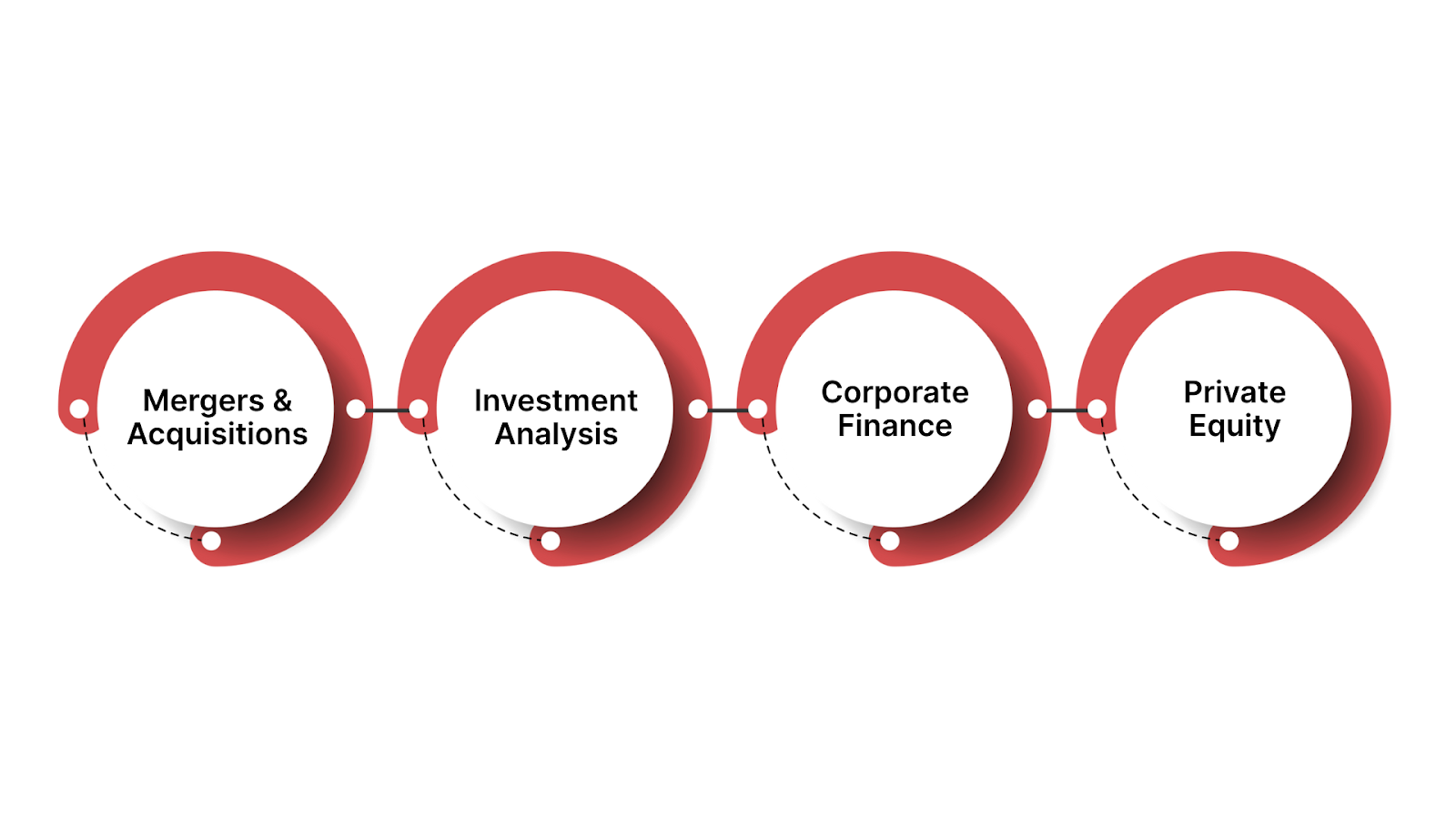
Enterprise Value (EV) is an important metric used in finance to assess a company’s total value, factoring in its equity, debt, and cash. It is commonly used in multiple financial applications, including comparisons through multiples such as EV/EBITDA, EV/FCF, and EV/Sales.
Key Applications of Enterprise Value in Finance:
The following are the major applications of EV in business and financial decision-making:
EV provides a complete view of a company’s value, making it a reliable basis for structuring and evaluating transactions.
For analysts and investors, EV offers a consistent way to evaluate companies across sectors and capital structures.
EV plays an important role in capital allocation and long-term financial planning within organizations.
Private equity firms apply EV at every stage of their investment cycle, from sourcing to exit.
In financial modeling, EV is crucial for modeling Free Cash Flow to Firm (FCFF), which assumes 100% ownership of a company’s assets. EV derived from FCFF helps calculate a company's true value.
For example, if Company A has a $60 million market cap, $20 million in cash, and no debt, its EV would be lower compared to Company B, which also has a $60 million market cap but carries $30 million of debt. EV takes into account both the cash and debt that affect the company’s overall worth.
Overall, Enterprise Value is a great metric used for various applications in finance, from M&A to investment analysis, corporate finance, and private equity.
To turn valuation insights into action, you need more than just formulas you need a system that simplifies finance at its core. Let’s explore that system below!

Understanding enterprise value gives you a full picture of a company’s financial worth debt, equity, and cash. But managing these numbers manually can lead to errors and wasted time. HAL ERP helps you take full control of financial data with automated journal entries, real-time insights, and reliable compliance tools.
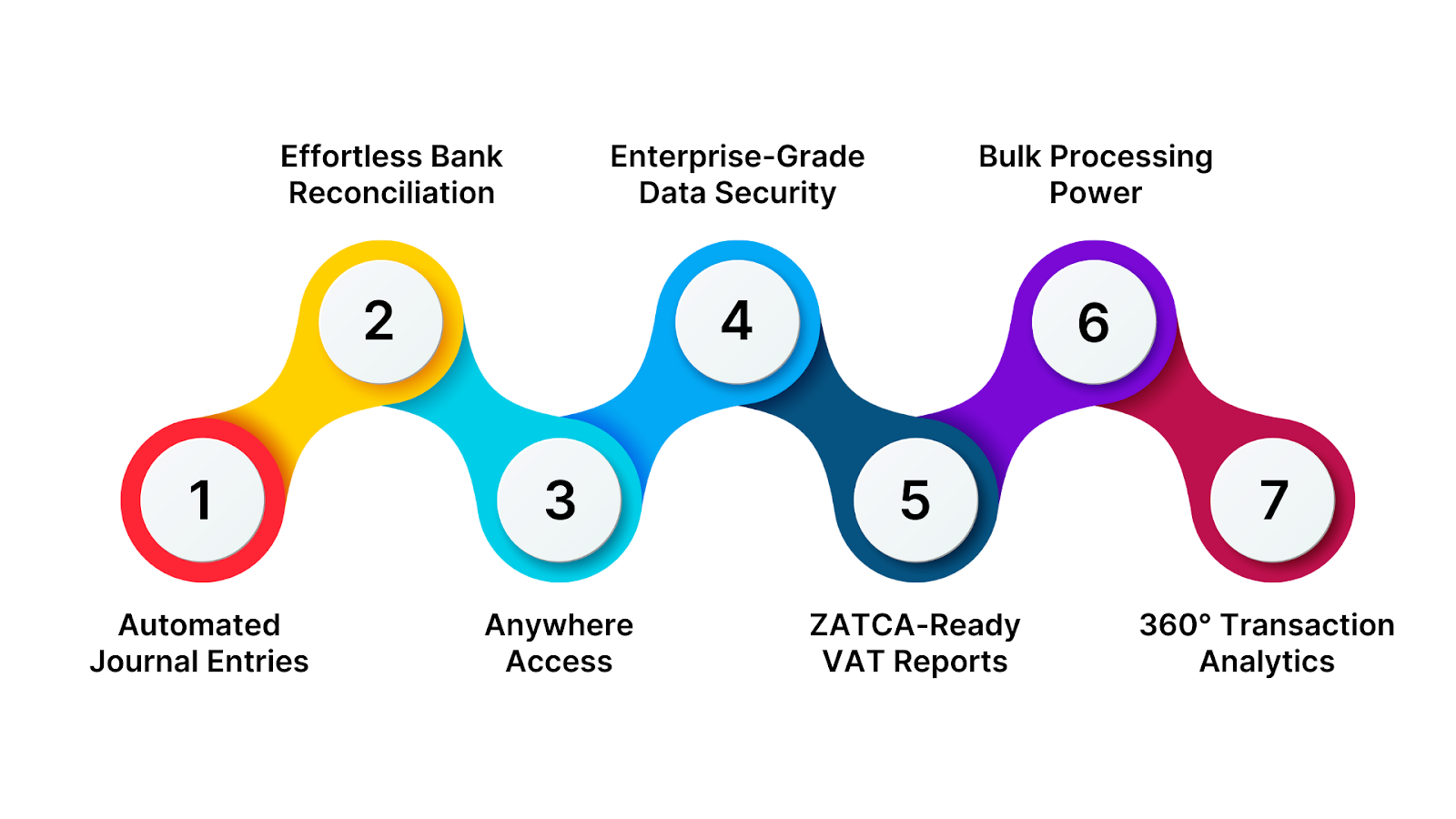
Ready to gain better control over your financial operations? Book your free demo today and see how HAL ERP helps you make faster, smarter, and more accurate financial decisions just like your valuation models.
Enterprise Value (EV) provides a comprehensive measure of a company’s true value by factoring in both equity and debt, offering a clearer picture than just market capitalization alone. EV plays a crucial role in evaluating potential acquisitions, as it provides insights into a company’s financial health beyond stock market movements. Understanding and calculating EV requires assessing various financial components, making it an essential tool for investment analysis and corporate strategy.
Want to simplify your business processes and gain deeper visibility into performance? HAL ERP adapts to your unique needs, bringing automation and insight to every function, from accounting to manufacturing.
Before you decide, talk to us for a free consultation and discover how our solutions can align with your reporting goals and operational challenges.
1. What is the difference between Enterprise Value and Market Capitalization?
Enterprise Value (EV) includes a company’s debt, cash, preferred shares, and other liabilities, providing a more complete picture of its worth. Market Capitalization, on the other hand, only reflects the value of a company’s outstanding equity (common shares).
2. Why is EV important in mergers and acquisitions?
EV is crucial in M&A because it accounts for both equity and debt, offering a true measure of the cost to acquire a company. It helps buyers understand the total financial commitment involved in the deal.
3. How can ERP systems assist in EV calculation?
ERP platforms like HAL ERP streamline financial reporting by automating data collection, ensuring data accuracy, and providing real-time insights, making EV calculations faster and more reliable.
4. How is EV different from Book Value?
Book Value is based on historical costs and reflects the value of a company’s assets minus liabilities according to its balance sheet. EV, however, incorporates market-based metrics and offers a more realistic view of a company’s current market value.
5. When should you use EV instead of Market Cap?
Use EV when you want a comprehensive view of a company’s financial health, especially in investment analysis, acquisitions, or comparing companies with varying capital structures.